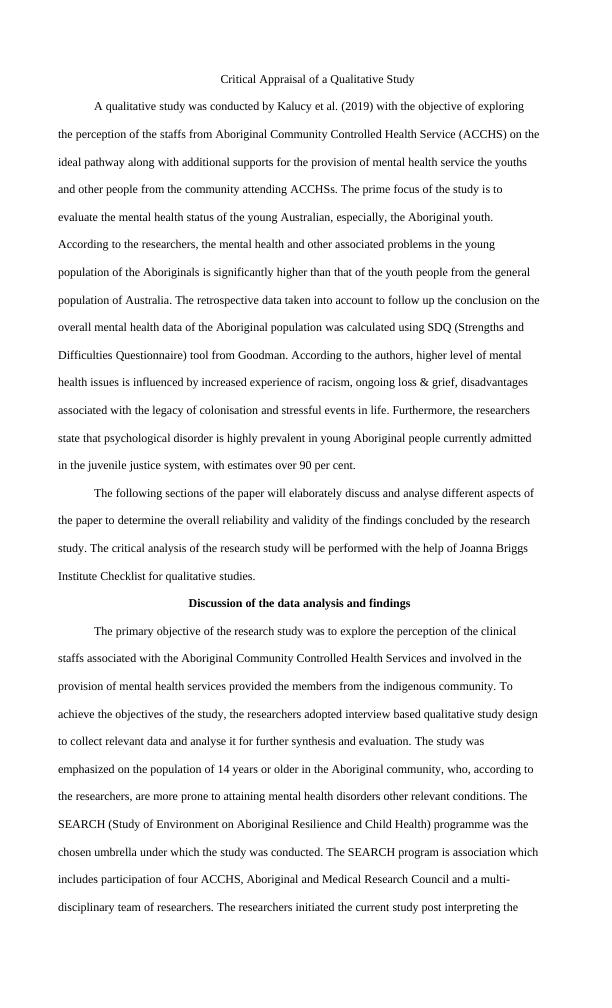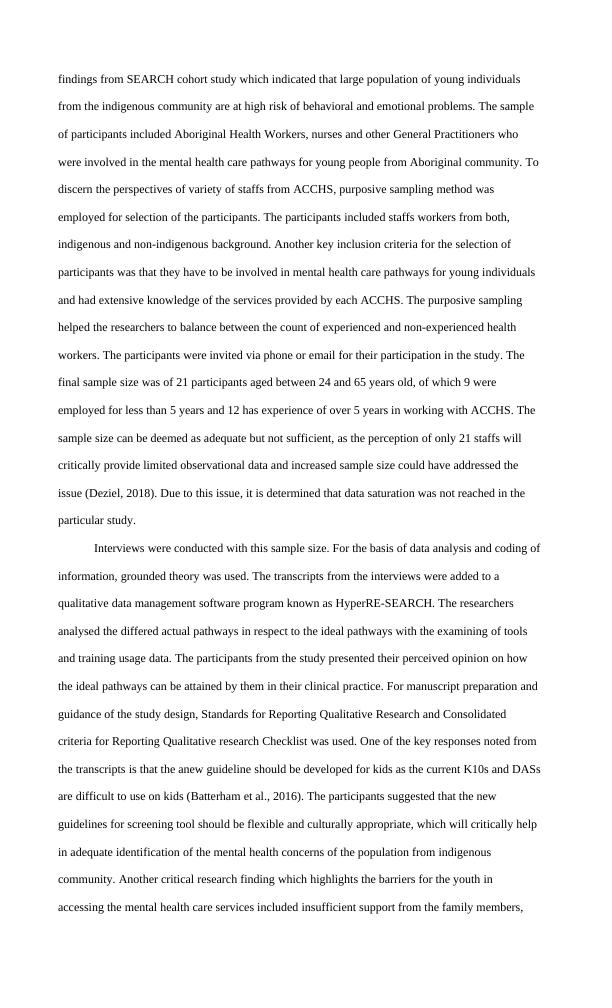Critical Appraisal of a Qualitative Study
Added on 2022-08-17
10 Pages2694 Words17 Views
Critical Appraisal of a Qualitative Study
Name of the Student
Name of the University
Author Note
Name of the Student
Name of the University
Author Note

Critical Appraisal of a Qualitative Study
A qualitative study was conducted by Kalucy et al. (2019) with the objective of exploring
the perception of the staffs from Aboriginal Community Controlled Health Service (ACCHS) on the
ideal pathway along with additional supports for the provision of mental health service the youths
and other people from the community attending ACCHSs. The prime focus of the study is to
evaluate the mental health status of the young Australian, especially, the Aboriginal youth.
According to the researchers, the mental health and other associated problems in the young
population of the Aboriginals is significantly higher than that of the youth people from the general
population of Australia. The retrospective data taken into account to follow up the conclusion on the
overall mental health data of the Aboriginal population was calculated using SDQ (Strengths and
Difficulties Questionnaire) tool from Goodman. According to the authors, higher level of mental
health issues is influenced by increased experience of racism, ongoing loss & grief, disadvantages
associated with the legacy of colonisation and stressful events in life. Furthermore, the researchers
state that psychological disorder is highly prevalent in young Aboriginal people currently admitted
in the juvenile justice system, with estimates over 90 per cent.
The following sections of the paper will elaborately discuss and analyse different aspects of
the paper to determine the overall reliability and validity of the findings concluded by the research
study. The critical analysis of the research study will be performed with the help of Joanna Briggs
Institute Checklist for qualitative studies.
Discussion of the data analysis and findings
The primary objective of the research study was to explore the perception of the clinical
staffs associated with the Aboriginal Community Controlled Health Services and involved in the
provision of mental health services provided the members from the indigenous community. To
achieve the objectives of the study, the researchers adopted interview based qualitative study design
to collect relevant data and analyse it for further synthesis and evaluation. The study was
emphasized on the population of 14 years or older in the Aboriginal community, who, according to
the researchers, are more prone to attaining mental health disorders other relevant conditions. The
SEARCH (Study of Environment on Aboriginal Resilience and Child Health) programme was the
chosen umbrella under which the study was conducted. The SEARCH program is association which
includes participation of four ACCHS, Aboriginal and Medical Research Council and a multi-
disciplinary team of researchers. The researchers initiated the current study post interpreting the
A qualitative study was conducted by Kalucy et al. (2019) with the objective of exploring
the perception of the staffs from Aboriginal Community Controlled Health Service (ACCHS) on the
ideal pathway along with additional supports for the provision of mental health service the youths
and other people from the community attending ACCHSs. The prime focus of the study is to
evaluate the mental health status of the young Australian, especially, the Aboriginal youth.
According to the researchers, the mental health and other associated problems in the young
population of the Aboriginals is significantly higher than that of the youth people from the general
population of Australia. The retrospective data taken into account to follow up the conclusion on the
overall mental health data of the Aboriginal population was calculated using SDQ (Strengths and
Difficulties Questionnaire) tool from Goodman. According to the authors, higher level of mental
health issues is influenced by increased experience of racism, ongoing loss & grief, disadvantages
associated with the legacy of colonisation and stressful events in life. Furthermore, the researchers
state that psychological disorder is highly prevalent in young Aboriginal people currently admitted
in the juvenile justice system, with estimates over 90 per cent.
The following sections of the paper will elaborately discuss and analyse different aspects of
the paper to determine the overall reliability and validity of the findings concluded by the research
study. The critical analysis of the research study will be performed with the help of Joanna Briggs
Institute Checklist for qualitative studies.
Discussion of the data analysis and findings
The primary objective of the research study was to explore the perception of the clinical
staffs associated with the Aboriginal Community Controlled Health Services and involved in the
provision of mental health services provided the members from the indigenous community. To
achieve the objectives of the study, the researchers adopted interview based qualitative study design
to collect relevant data and analyse it for further synthesis and evaluation. The study was
emphasized on the population of 14 years or older in the Aboriginal community, who, according to
the researchers, are more prone to attaining mental health disorders other relevant conditions. The
SEARCH (Study of Environment on Aboriginal Resilience and Child Health) programme was the
chosen umbrella under which the study was conducted. The SEARCH program is association which
includes participation of four ACCHS, Aboriginal and Medical Research Council and a multi-
disciplinary team of researchers. The researchers initiated the current study post interpreting the

findings from SEARCH cohort study which indicated that large population of young individuals
from the indigenous community are at high risk of behavioral and emotional problems. The sample
of participants included Aboriginal Health Workers, nurses and other General Practitioners who
were involved in the mental health care pathways for young people from Aboriginal community. To
discern the perspectives of variety of staffs from ACCHS, purposive sampling method was
employed for selection of the participants. The participants included staffs workers from both,
indigenous and non-indigenous background. Another key inclusion criteria for the selection of
participants was that they have to be involved in mental health care pathways for young individuals
and had extensive knowledge of the services provided by each ACCHS. The purposive sampling
helped the researchers to balance between the count of experienced and non-experienced health
workers. The participants were invited via phone or email for their participation in the study. The
final sample size was of 21 participants aged between 24 and 65 years old, of which 9 were
employed for less than 5 years and 12 has experience of over 5 years in working with ACCHS. The
sample size can be deemed as adequate but not sufficient, as the perception of only 21 staffs will
critically provide limited observational data and increased sample size could have addressed the
issue (Deziel, 2018). Due to this issue, it is determined that data saturation was not reached in the
particular study.
Interviews were conducted with this sample size. For the basis of data analysis and coding of
information, grounded theory was used. The transcripts from the interviews were added to a
qualitative data management software program known as HyperRE-SEARCH. The researchers
analysed the differed actual pathways in respect to the ideal pathways with the examining of tools
and training usage data. The participants from the study presented their perceived opinion on how
the ideal pathways can be attained by them in their clinical practice. For manuscript preparation and
guidance of the study design, Standards for Reporting Qualitative Research and Consolidated
criteria for Reporting Qualitative research Checklist was used. One of the key responses noted from
the transcripts is that the anew guideline should be developed for kids as the current K10s and DASs
are difficult to use on kids (Batterham et al., 2016). The participants suggested that the new
guidelines for screening tool should be flexible and culturally appropriate, which will critically help
in adequate identification of the mental health concerns of the population from indigenous
community. Another critical research finding which highlights the barriers for the youth in
accessing the mental health care services included insufficient support from the family members,
from the indigenous community are at high risk of behavioral and emotional problems. The sample
of participants included Aboriginal Health Workers, nurses and other General Practitioners who
were involved in the mental health care pathways for young people from Aboriginal community. To
discern the perspectives of variety of staffs from ACCHS, purposive sampling method was
employed for selection of the participants. The participants included staffs workers from both,
indigenous and non-indigenous background. Another key inclusion criteria for the selection of
participants was that they have to be involved in mental health care pathways for young individuals
and had extensive knowledge of the services provided by each ACCHS. The purposive sampling
helped the researchers to balance between the count of experienced and non-experienced health
workers. The participants were invited via phone or email for their participation in the study. The
final sample size was of 21 participants aged between 24 and 65 years old, of which 9 were
employed for less than 5 years and 12 has experience of over 5 years in working with ACCHS. The
sample size can be deemed as adequate but not sufficient, as the perception of only 21 staffs will
critically provide limited observational data and increased sample size could have addressed the
issue (Deziel, 2018). Due to this issue, it is determined that data saturation was not reached in the
particular study.
Interviews were conducted with this sample size. For the basis of data analysis and coding of
information, grounded theory was used. The transcripts from the interviews were added to a
qualitative data management software program known as HyperRE-SEARCH. The researchers
analysed the differed actual pathways in respect to the ideal pathways with the examining of tools
and training usage data. The participants from the study presented their perceived opinion on how
the ideal pathways can be attained by them in their clinical practice. For manuscript preparation and
guidance of the study design, Standards for Reporting Qualitative Research and Consolidated
criteria for Reporting Qualitative research Checklist was used. One of the key responses noted from
the transcripts is that the anew guideline should be developed for kids as the current K10s and DASs
are difficult to use on kids (Batterham et al., 2016). The participants suggested that the new
guidelines for screening tool should be flexible and culturally appropriate, which will critically help
in adequate identification of the mental health concerns of the population from indigenous
community. Another critical research finding which highlights the barriers for the youth in
accessing the mental health care services included insufficient support from the family members,

End of preview
Want to access all the pages? Upload your documents or become a member.
Related Documents
Social and Emotional Wellbeing of Indigenous Australian Children and Adolescentslg...
|4
|848
|132
Mental Health issues among Aboriginals | Researchlg...
|12
|2489
|17
Determinants of Mental Health in Aboriginal Communitieslg...
|10
|2877
|425
Incarcerated Aboriginal and Torres Strait Islander People: Understanding the Prevalence of Mental Illnesslg...
|3
|1679
|199
Native Australians Had a Significantly Greater Burden of Illnesslg...
|3
|1736
|13
Suicide Rates in Aboriginal Communities in Labrador, Canadalg...
|6
|1629
|17